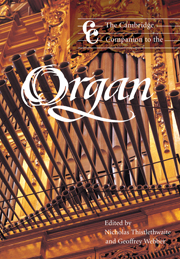3 - The physics of the organ
from Part I - The instrument
Published online by Cambridge University Press: 28 September 2011
Summary
Introduction
The ancient Greek philosopher Zeno of Citium (c335–263 BC) tells us that the reason we have two ears and only one mouth is so that we may hear more and speak less. We could dismiss this utterance from the founder of the Stoics in Athens as mere wishful thinking on the part of one who argued that the elements of physics and logic must serve the element of ethics; we might even declare it to be rubbish! Paradoxically, there are some grains of truth in his statement. Two ears do hear more than one; we experience binaural summation. At least for moderate intensities, a sound heard in two ears at once does seem to be about twice as loud as the same sound heard in one ear only. Our hearing system must obviously be ‘wired’ differently from our seeing system – closing one eye does not change the brightness of the scene in front of us. Nevertheless, binaural summation really has little to do with the main purpose of the two-eared system we have inherited.
We have two ears so that we may hear more, but in the late twentieth century AD the word ‘more’ has to be interpreted in a subtle way. Our ears allow us to use, quite unconsciously, very small time differences (and, at high frequencies, intensity differences) associated with the binaural reception of sound, for location and discrimination within a complex acoustic environment. A solo violin or clarinet represents a localised source of sound for the listener, who is able to recognise the particular type of instrument through its tone quality or timbre.
- Type
- Chapter
- Information
- The Cambridge Companion to the Organ , pp. 31 - 41Publisher: Cambridge University PressPrint publication year: 1999



